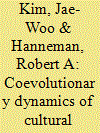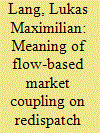| Srl | Item |
| 1 |
ID:
128977


|
|
|
|
|
| Publication |
2014.
|
| Summary/Abstract |
The emergence and institutionalization of cooperation in sizable groups without reciprocity receives considerable attention in game-theoretical modeling. Agents in our study play the Prisoner's Dilemma game cooperating with tolerably similar neighbors. They may imitate cultural markers (tags) and tolerance from more successful neighbors. Alternatively, they break ties to out-group neighbors. New partners are selected either from neighbors' neighbors (clustering) or randomly. Variations in network plasticity (the likelihood of changing partners rather than being influenced) and clustering are explored. With high plasticity and high clustering, networks tend to fragment. With low plasticity and low clustering, networks tend toward global cooperation, but with severe losses of cultural diversity and tolerance. Cooperation in such regimes also proves to be vulnerable to defection. Between, there is a space displaying relatively stable and widespread cooperation with diversity and tolerance. We note some important structural characteristics of the networks evolving in this space.
|
|
|
|
|
|
|
|
|
|
|
|
|
|
|
|
| 2 |
ID:
169843


|
|
|
|
|
| Summary/Abstract |
Energy market modelling lacks an approach that tackles the implications of flow-based market coupling on congestion management in European electricity markets. Especially in the context of high shares of renewable energy, the topic of network congestion is becoming even more important. Usually, redispatch measures as a main part of congestion management are calculated on the basis of a simple load flow model incorporating net transfer capacities on the day-ahead market. In this paper, we suggest a modelling approach that incorporates the attributes of flow-based market coupling in the calculation of congestion management. An advanced load flow model is therefore already used to reflect the allocation process on the spot market. Retaining this result, necessary congestion management can be calculated on the basis of a more detailed network model representing the control areas’ exact transmission lines. Also, we conduct a comparison between the net transfer capacity- and the flow-based market coupling approach representing different levels of grid-granularities to show the importance of the grid model used for allocation on the European market for electricity. The results suggest, that necessary congestion management in the system is heavily dependent on the grid granularity, both in the sign and magnitude.
|
|
|
|
|
|
|
|
|
|
|
|
|
|
|
|